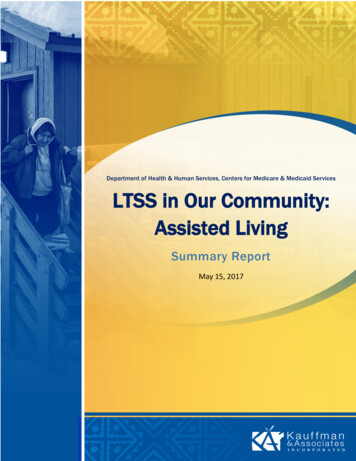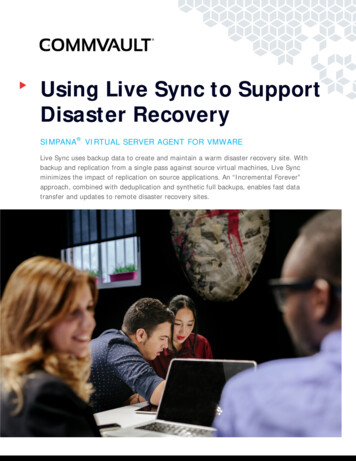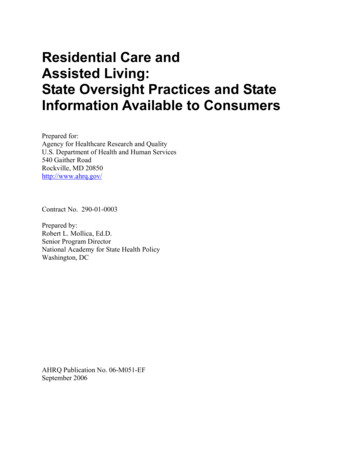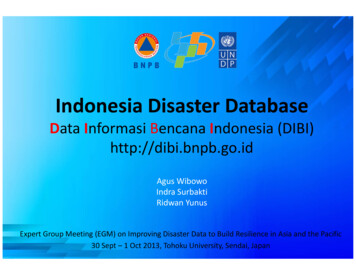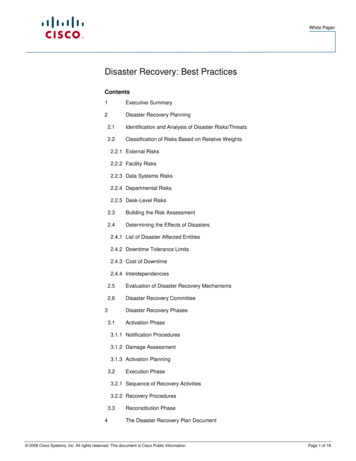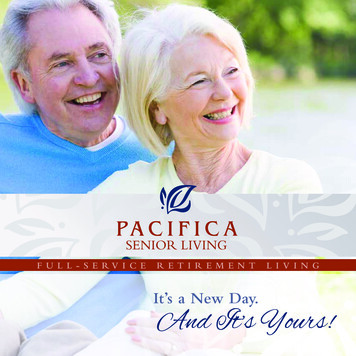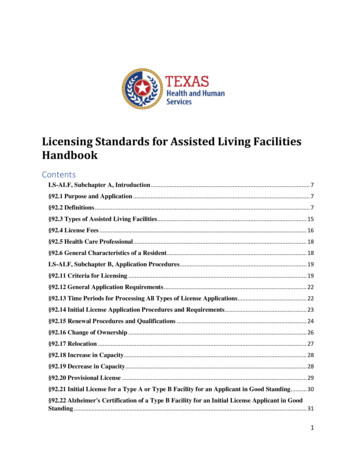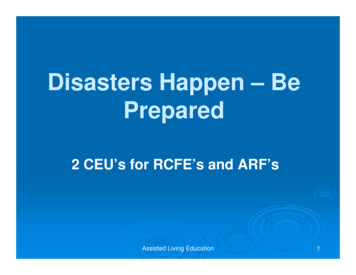
Transcription
Disasters Happen – BePrepared2 CEU’s for RCFE’s and ARF’sAssisted Living Education1
Copyright & Disclaimer COPYRIGHT - This Course Material has been copyrighted 2009 byAssisted Living Education. All rights reserved. No part of this coursematerial/content may be reproduced or utilized in any form, by any means,electronic or mechanical, including photocopying, recording, emailing, orany information storage and retrieval system, without permission in writingfrom Assisted Living Education. DISCLAIMER - Assisted Living Education has attempted to offer usefulinformation and assessment tools that have been accepted and used byprofessionals within this industry, including the California Department ofSocial Services. Nevertheless, changes in health/medical care and healthcare regulations may change the application of some techniques andperceptions in this course material. Assisted Living Education therebydisclaims any liability for loss, injury or damage incurred as a consequence,either directly or indirectly, from the use and application of any of thecontents of this course material.Assisted Living Education2
Why?36 residents of long-term carefacilities died in their beds in theaftermath of Hurricane Katrina.We lost several RCFE’s in theSan Diego fires.Assisted Living Education3
Course Objectives Determine what is required by Stateregulations?Developing your disaster plan that isrealisticDiscuss a 72-hour shelter-in-place planDiscuss perishable and non-perishablefood suppliesTraining your staff properlyAssisted Living Education4
Your Disaster Plan - Be PreparedAssisted Living Education5
DSS RequirementsThe Emergency Disaster Plan is discussedin both Title 22 and the Health & SafetyCodes.Title 22, Section 87212H&S 1569.695You also need a current LIC 610E &facility sketchAssisted Living Education6
Your Disaster Plan1.2.3.4.5.6.7.Staff assignments and traininga.Emergency drillsb.Types of disastersEvacuationsTransportationRelocation sitesa.Supervising the residentsEmergency Agency contactsRelocation plansEvacuating in placeAssisted Living Education7
Your Disaster Plan (cont’d)Staff assignments and training: Make sure your staff knows where yourDisaster Binder is located and what’s in it Are their first aid cards current?Assisted Living Education8
Your Disaster Plan (cont’d)Staff assignments and training (cont’d): Where are your utility shut-offs located? Where are your exits located?ones lead directly outside?Assisted Living EducationWhich9
Your Disaster Plan (cont’d)Staff assignments and training (cont’d): How often do you have fire and disasterdrills? How do you conduct a fire drill? Answer: Quarterly for each shift andmake sure this is documented in writingAssisted Living Education10
Your Disaster Plan (cont’d)Staff assignments and training (cont’d): Part of your new employee Orientationshould be a complete review of yourdisaster policies and procedures Why not train your residents and families,too?Assisted Living Education11
Your Disaster Plan (cont’d)Staff assignments and training (cont’d): Who is going to call: DSSFamiliesHospicePhysicians, if necessaryAssisted Living Education12
Your Disaster Plan (cont’d)A complete and current Resident Roster must be keptat the facility at all times.In the event of an emergency, this Resident Roster willbe given to the emergency personnel and used toidentify residents and their special needs (such as“bedridden”).The DSS Form LIC 9020 can be utilized as a ResidentRoster.Assisted Living Education13
Your Disaster Plan (cont’d)Training your staff:1.You can use the DSS Self-AssessmentTool titled “Disaster Guide.” Note: written in2007 – all of the reg #’s have changedCall your local fire department to see ifthey will provide training (staff and residents!)3. Call your local Red Cross chapter to seeif they will provide training (staff and residents!)2.Assisted Living Education14
Your Disaster Plan (cont’d)Your Plan also needs to address how youwill deal with your dementia and bedriddenresidents.Physically evacuating them2. Supervision while out of the facility3. Transfer trauma4. Delayed egress units – guard the doors!!!!1.Assisted Living Education15
Assisted Living Education16
Types of DisastersThere are two types of disaster conditions internal and external.An internal disaster is defined as any situationthat occurs within the facility causing adisruption of normal routine, injury and/orproperty damage. An example of an internaldisaster is a gas explosion in the kitchen.Assisted Living Education17
FireFire:Initial steps to take:1.2.3.Check the batteries in your smoke detectorregularly – change at least once a year.Keep your fire extinguisher in a central location(kitchen preferably).Never leave the kitchen when something is onthe stove.Assisted Living Education18
Fire (cont’d)Fire extinguishers:Per the Red Cross only use a fireextinguisher if: The fire is confined to a small area, and is not growing.The room is not filled with smoke.Everyone has exited the building.The fire department has been called.Assisted Living Education19
Fire (cont’d)Remember PASS when using a fireextinguisher:Pullthe pin and hold the extinguisher with thenozzle pointing away from you.Aim low. Point the extinguisher at the base of thefire.Squeeze the lever slowly and evenly.Sweep the nozzle from side to side.Assisted Living Education20
Fire (cont’d)Remember to GET OUT,STAY OUT and CALL 9-1-1or your local emergencyphone number.Assisted Living Education21
Fire (cont’d) If closed doors or handles are warm, use yoursecond way out. Never open doors that arewarm to the touch.Crawl low under smoke.Go to your outside meeting place and then callfor help.If smoke, heat or flames block your exit routes,stay in the room with doors closed. Place a wettowel under the door and call the fire departmentor 9-1-1.Assisted Living Education22
Fire (cont’d) Opena window and wave a brightlycolored cloth or flashlight to signal for help. Never go back into a burning building forany reason. Get out and stay out! If your clothes catch on fire, drop to thefloor and roll to suffocate the fire. Keeprolling (running from the fire only “fans” theflames and makes it worse).Assisted Living Education23
Power OutageTo prepare:1.2.3.Have an emergency preparedness kit:flashlights, a cooler, water, food, extrabatteries.If you have delayed egress, you must havea plan in place for guarding the doors!Do you have an emergency generator anddoes everyone know how to work it?Assisted Living Education24
Power OutageDuring an outage:Keep your food safe. Per the Red Cross, ifa power outage is 2 hours or less, you neednot be concerned about losing yourperishable foods.Assisted Living Education25
Power Outage (cont’d)Keeping your food safe:a.b.c.Keep refrigerator and freezer doors closed asmuch as possible. First use perishable food fromthe refrigerator. An unopened refrigerator willkeep foods cold for about 4 hours.Then use food from the freezer. A full freezer willkeep the temperature for about 48 hours (24 hoursif it is half full) if the door remains closed.Use your non-perishable foods and staples afterusing food from the refrigerator and freezer.Assisted Living Education26
Power Outage (cont’d)During an outage:What about your delayed egress doors? If you have delayed egress doors, they will mostlikely be deactivated.Now what?Assign guards to each door.Assisted Living Education27
Power Outage (cont’d)During an outage: Use flashlights only – do not use candles or anyopen-flame lighting. Staff should go to each room to check on residents. Ask residents to keep their room doors open toreceive light from the hallways, but secure pets ifthey have a pet. Also, ask residents to open theirblinds/curtains for an outside light source (in daylighthours).Assisted Living Education28
Power Outage (cont’d)During an outage: Plan to use cell phones or walkie-talkies tocommunicate.Turn off electrical equipment that was in use when thepower went out as it might surge when the power goesback on.If it is hot outside, move residents to areas that arecooler, such as lower floor rooms. Avoid openingwindows or doors.Residents with motorized scooters will need to usemanual wheelchairs during the outage.Assisted Living Education29
Power Outage (cont’d)During an outage:Assistive Devices - Oxygen Concentrators:Residents using an oxygen concentrator should have aportable oxygen concentrator or appropriate backupoxygen tanks available for power failures. During a powerfailure, the resident should be assisted to switch to thebackup oxygen tank.Portable oxygen concentrators usually can also be pluggedinto the DC outlet of a vehicle, and most of these deviceshave the ability to run from electric batteries, also, forambulatory use.Assisted Living Education30
Power Outage (cont’d)During an outage:Assistive Devices – CPAP machines:Residents that use CPAP machines should have sufficientbackup batteries that are kept charged at all times. endations for alternative equipment to be usedduring long term power failure.Assisted Living Education31
Power Outage (cont’d)During an outage:Adjustable/Motorized Beds Use for Repositioning:Residents that use an adjustable, motorized bed forrepositioning purposes will be assisted to reposition, ifnecessary. If the bed has mechanical controls, the bedcan be adjusted manually. If not, pillows or wedges can beused for positioning, according to the resident’s needs.Assisted Living Education32
Power Outage (cont’d)During an outage:Motorized Scooters:Residents with motorized scootersshould switch to either theirbattery pack or a manualwheelchair, or other assistivedevicethatthephysicianrecommends (i.e., walker).Assisted Living Education33
Power Outage (cont’d)Medications:1.2.Check medications that require refrigeration to be sureyou know if they will be affected by a prolongedinterruption of power. Consult a doctor or pharmacist ifyou're not sure.A cooler can be used to store medications that requirerefrigeration during a power outage, such as insulin.The cooler must be stored in a locked location.1.2.The only staff allowed access to this medication will be theAdministrator and the trained medication technicians.Avoid opening the cooler unnecessarily.Assisted Living Education34
Power Outage (cont’d)Medications (cont’d):3.4.5.Refrigerated medications should be placed intoTupperware or zip-top plastic bags that are labeled withthe resident’s name and its contents and placed on thetop of the ice in the cooler.If a cooler is not available, ice can be placed in abathroom sink or bathtub and the medications in theclosed containers can be locked in the bathroom.\When power comes back on, the medications will betransferred back to their original location, when therefrigerator is at the proper temperature (between 36and 46 degrees).Assisted Living Education35
Water and Gas OutageOther potential outages:watergasAssisted Living Education36
Types of DisastersThere are two types of disaster conditions internal and external.An external disaster is defined as any situationthat occurs outside the facility that causesinjury, structural damage and/or general chaos.An example would be an earthquake.Assisted Living Education37
EarthquakeEarthquake preparation:1.Pick safe places in each room of yourhome or workplace. A safe place couldbe under a piece of furniture or againstan interior wall away from windows,bookcases or tall furniture that could fallon you.Assisted Living Education38
Earthquake (cont’d)Earthquake preparation:2.Did you know that doorways are no strongerthan any other part of the structure?3.Practice drop, cover and hold on in each safeplace. If you do not have sturdy furniture tohold on to, sit on the floor next to an interiorwall and cover your head and neck with yourarms.Assisted Living Education39
Earthquake (cont’d)Earthquake preparation:Keep a flashlight and sturdy shoes byeach person’s bed.5. Bolt and brace water heaters and gasappliances to wall studs.6. Bolt bookcases, china cabinets andother tall furniture to wall studs.4.Assisted Living Education40
Earthquake (cont’d)Earthquake preparation:Hang heavy items, such as pictures andmirrors, away from beds, couches andanywhere people sleep or sit.8. Learn how to shut off the gas valves inyour home and keep a wrench handy forthat purpose.7.Assisted Living Education41
Earthquake (cont’d)During an earthquake (you are indoors): Drop, cover and hold on. Move as littleas possible. If you are in bed, stay there, curl up andhold on. Protect your head with a pillow. Stay away from windows to avoid beinginjured by shattered glass.Assisted Living Education42
Earthquake (cont’d)During an earthquake (you are indoors): Stay indoors until the shaking stops and youare sure it is safe to exit. If you must leave thebuilding after the shaking stops, use stairs ratherthan an elevator in case there are aftershocks,power outages or other damage. Be aware that fire alarms and sprinkler systemsfrequently go off in buildings during anearthquake, even if there is no fire.Assisted Living Education43
Earthquake (cont’d)During an earthquake (you are outdoors):Find a clear spot and drop to the ground. Stay there until the shaking stops (awayfrom buildings, power lines, trees,streetlights). Assisted Living Education44
Earthquake (cont’d)After an earthquake: Expect and prepare for potential aftershocks. Check yourself for injuries and get first aid, ifnecessary, before helping injured or trappedpersons. Look quickly for damage in and around your homeand get everyone out if your home is unsafe. Call for emergency services, if necessary, and callthe resident families. Turn off the gas, if necessary.Assisted Living Education45
Earthquake (cont’d)After an earthquake (cont’d): Turn off the gas, if necessary. Are high traffic areas, such as hallways, commonareas, and doorways, clear of debris so residentsmay move freely throughout the facility? Check to see - Did the facility suffer any significantstructural damage?Assisted Living Education46
Heat Wave or Extreme HeatIn the event of a heat wave or extreme heat: Stay indoors as much as possible and limit exposureto the sun. Stay on the lowest floor out of the sunshine if airconditioning is not available. Keep yourself and the residents well hydrated bydrinking plenty of fluids even if you/they do not feelthirsty.Assisted Living Education47
Heat Wave or Extreme Heat(cont’d)In the event of a heat wave or extreme heat: Avoid drinks with caffeine or alcohol. Persons who have epilepsy or heart, kidney, or liverdisease; are on fluid-restricted diets; or have aproblem with fluid retention should consult a doctorbefore increasing liquid intake. Eat well-balanced, light, and regular meals. Serve small meals and eat more often.Assisted Living Education48
EvacuationsAssisted Living Education49
EvacuationsEvacuation Relocation Sites: You must have at least 2 choices. What are good evacuation sites? Where are yours?Assisted Living Education50
Evacuations (cont’d)Evacuations (cont’d): How are you going to keep yourresidents safe?How are you going to inform thefamilies and DSS?How are you going to evacuate yourmedications?Do your families know where they are?Assisted Living Education51
Evacuations (cont’d)Evacuations (cont’d):Medications:Can you evacuate them easily?What if they need refrigeration?Grab your Med Records!Assisted Living Education52
Evacuations (cont’d)Methods of assisting residents include:o Walkers and wheelchairs, if available.o Rolling the resident’s bed through doorways anddown hallways (if their bed has wheels and is able tomove).o HIP CARRY – One person carrying one Resident(only when necessary).o SADDLE CARRY – Two persons locking hands andwrists to form a chair.o BLANKET CARRY – One person dragging oneResident placed on a blanket.Assisted Living Education53
Evacuations (cont’d)Idea:Create an Emergency BinderResident RosterLIC 601’s (Emergency Info)Physician ReportsMedication ListsInsurance CardsDNR’s, POLST’s, etc.Assisted Living Education54
TransportationTransportation arrangements:Your own car ora bus?Assisted Living Education55
Transportation (cont’d)In your car, have:1.2.3.4.gasemergency informationfirst aid kitblanketsNote: When you leave, lock the facility doorbehind you.Assisted Living Education56
Transportation (cont’d)If you’re transporting by bus:Residents should be triaged for specific buses. Ambulatory residents should be loaded first, thenwheelchair residents who need minimal assistance. Loading the most dependent residents last providesthe capability of caring for them until departure andunloading them off the bus first. Assisted Living Education57
Transportation (cont’d)If you’re transporting by bus (cont’d):Buses should be staffed according to acuity of theresidents, using at least two staff members per bus. When possible, roommates should be placedtogether on the bus, as familiarity has been shownto reduce anxiety and agitation. When time allows, completion of a walk-throughcheck, including all bathrooms, should be performedto ensure that no resident is left behind. Assisted Living Education58
Shelter in PlaceAssisted Living Education59
Shelter in PlaceWe need to come up with a plan to be selfsufficient for at least 72 hours.What will we do?What will we eat?Where will your employees want to go(answer: HOME!)? Now what?Assisted Living Education60
Shelter in Place (cont’d)Let’s think about What if our resident uses oxygen?What if our resident uses a nebulizer?What if our resident uses an motorizedscooter?Assisted Living Education61
Shelter in Place (cont’d)If you use emergency call buttons, they mostlikely won’t work. Now what?whistles or bellshourly checks on residentspossible 24/7 supervision of dementiaresidentsAssisted Living Education62
Shelter in Place (cont’d)When communicating with stressed residents, speakslowly and clearly, as some residents may show adelayed response to a crisis and may not comprehendthe magnitude of the situation or possible dangers.When communicating with Alzheimer’s/dementiaresidents, identify yourself and briefly state why youare there. It is important to talk slowly and use theappropriate tone of voice. Ask yes or no questionsand maintain eye contact. Turn off bright lights and tryto minimize siren noise, if possible.Assisted Living Education63
Food Supplies DSSrequires 2 days of perishables DSS requires 7 days of non-perishablesGood non-perishables:canned foods – fruit, vegetables,beans, protein (i.e. tuna)cerealspeanut butter and crackersAssisted Living Education64
Food Supplies (cont’d)They didn’t mentionwater How much should wehave?Suggested: 3-day supply of potablewater with one gallon of water perresident per dayAssisted Living Education65
Disaster KitsThe Alzheimer’s Association suggests preparing anemergency kit in advance. Keep it in a watertightcontainer and store it in an easily accessible location.Your emergency kit might include: Easy on/off clothes (a couple of sets).Supplies of medication (or minimally, a list ofmedications with dosages).Velcro shoes/sneakers.A spare pair of eyeglasses.Incontinence products.Assisted Living Education66
Disaster Kits (cont’d) Extra identification items for the person, such as an IDbracelet and clothing tags.Copies of legal documents, such as a power ofattorney.Copies of medical documents that indicate theindividual’s condition and current medications.Copies of insurance and Social Security cards.Use waterproof bags to hold medications anddocuments.Physician’s name, address and phone numbers(including cell phone).Assisted Living Education67
Facility ReentryFacility Reentry Plan: Who will authorize reentry to the facility after anevacuation? Procedures for inspecting the facility How it will be determined when it is safe to return tothe facility after an evacuation? How will you get the residents back to the facility?Assisted Living Education68
ConclusionAssisted Living Educationthanks you for attending ourcourse.We look forward to seeing you again atanother of our courses!Assisted Living Education69
Training your staff properly Assisted Living Education 4. Assisted Living Education 5 Your Disaster Plan - Be Prepared . DSS Requirements The Emergency Disaster Plan is discussed in both Title 22 and the Health & Safety Codes. Title 22, Section 87212 H&S 1569.695 You also need a current LIC 610E &
